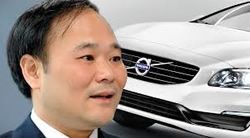 Flyt för Aras PLM: - De senaste årens vinnare när det gäller nya användare
Flyt för Aras PLM: - De senaste årens vinnare när det gäller nya användare
 Flyt för Aras PLM: - De senaste årens vinnare när det gäller nya användare
Flyt för Aras PLM: - De senaste årens vinnare när det gäller nya användare
 ”Great ERP, worse PLM” – What SAP PLM needs to sharpen its competitive edge
”Great ERP, worse PLM” – What SAP PLM needs to sharpen its competitive edge
 PLM Spending: A period of “Digestion” after two years of explosive growth
PLM Spending: A period of “Digestion” after two years of explosive growth
 The Market for PLM Services: Why Accenture thinks they can rattle IBM
The Market for PLM Services: Why Accenture thinks they can rattle IBM
 TV-report: The Internet of Things – The secret to what PLM and ERP can do in the smart revolution
TV-report: The Internet of Things – The secret to what PLM and ERP can do in the smart revolution
 Not ”a load of crap” anymore: ”PLM 360 is way ahead of plan”, says Autodesk’s Carl Bass
Not ”a load of crap” anymore: ”PLM 360 is way ahead of plan”, says Autodesk’s Carl Bass
 "Demolish the silos in PLM": Why Dassaults Bernard Charles believes in the 3D Experience
"Demolish the silos in PLM": Why Dassaults Bernard Charles believes in the 3D Experience
 The Next Big Boom in PLM and ERP and the Battle Over mBOM Ownership
The Next Big Boom in PLM and ERP and the Battle Over mBOM Ownership
 From the graveyard of ERP to the world’s largest start-up: Infor TV Report
From the graveyard of ERP to the world’s largest start-up: Infor TV Report
 What Happened to Volvo engineering and PLM under Chinese ownership?
What Happened to Volvo engineering and PLM under Chinese ownership?
 Will GE and PTC’s joint venture create a ”PLM and manufacturing advantage”?
Will GE and PTC’s joint venture create a ”PLM and manufacturing advantage”?
 Inside Daimler Mercedes Switch from Dassault Systèmes to Siemens PLM and NX
Inside Daimler Mercedes Switch from Dassault Systèmes to Siemens PLM and NX
 Truck Maker’s PLM Model a Focus in Volkswagen’s War Over Ownership
Truck Maker’s PLM Model a Focus in Volkswagen’s War Over Ownership
 The Role of 3D Printing in Manufacturing and PLM – TV Report
The Role of 3D Printing in Manufacturing and PLM – TV Report
 The Third Platform – A Quantum Leap for PLM and ERP
The Third Platform – A Quantum Leap for PLM and ERP
 SolidWorks Mechanical Conceptual: Late and Great, but too Expensive? – TV Report
SolidWorks Mechanical Conceptual: Late and Great, but too Expensive? – TV Report
 Big Data – Big Problem? – TV Report
Big Data – Big Problem? – TV Report
 Applauds to the European Parliament’s call to modernise EU public works projects with BIM technology
Applauds to the European Parliament’s call to modernise EU public works projects with BIM technology
 Siemens, Tesis PLMware and Industry 4.0
Siemens, Tesis PLMware and Industry 4.0
 Why PTC acquired ThingWorx and how M2M will change everything
Why PTC acquired ThingWorx and how M2M will change everything
 Autodesk’s CEO, Carl Bass: We want to change the way people work – TV Report
Autodesk’s CEO, Carl Bass: We want to change the way people work – TV Report
 How MOBILITY transforms Product Development, Manufacturing and Service – TV Report
How MOBILITY transforms Product Development, Manufacturing and Service – TV Report
 Can PLM Systems Manage Highly Complex Products? – TV Report
Can PLM Systems Manage Highly Complex Products? – TV Report
 Dassault’s 3DEXPERIENCE Platform – TV Report
Dassault’s 3DEXPERIENCE Platform – TV Report
 PLM Systems Cleared for Take Off at Airbus
PLM Systems Cleared for Take Off at Airbus
 FRONTRUNNERS Takes a Look Inside Volvo’s Construction Equipment
FRONTRUNNERS Takes a Look Inside Volvo’s Construction Equipment
 Battle of the Visions part 3: PTC breaks new ground in the PLM landscape - claims CEO Jim Heppelmann
Battle of the Visions part 3: PTC breaks new ground in the PLM landscape - claims CEO Jim Heppelmann
 User experience the deciding factor when Dutch shipbuilder, Damen, chose IFS
User experience the deciding factor when Dutch shipbuilder, Damen, chose IFS
 PTC’s Windchill 10.0 – will 100 million in R&D take PLM to the next level?
PTC’s Windchill 10.0 – will 100 million in R&D take PLM to the next level?
 The French Connection ...more possibilities than problems, when SolidWorks is “dassaultified”?
The French Connection ...more possibilities than problems, when SolidWorks is “dassaultified”?
 Management swap at SolidWorks - Jeff Ray Steps down as CEO, Bertrand Sicot takes over
Management swap at SolidWorks - Jeff Ray Steps down as CEO, Bertrand Sicot takes over
 SolidWorks’ Jeff Ray confirms in an interview transition to Dassault’s V6 platform
SolidWorks’ Jeff Ray confirms in an interview transition to Dassault’s V6 platform
 15/04/2014
PLM
15/04/2014
PLM
 VERKSTADSFORUM.SE:S TELEGRAMREDAKTION
VERKSTADSFORUM.SE:S TELEGRAMREDAKTION
What Happened to Volvo engineering and PLM under Chinese ownership?

Bildtext: Li Shufu, Chairman of Volvo owner Geely
A Western European automaker in the hands of Chinese owners? Could that work? Yes, surprisingly well so far. The case in point is the formerly Ford-owned Volvo. In 2010 it was sold to Chinas Geely Automobile for $ 1.8 billion.
Naturally there were fears about the intentions of Geelys founder and chairman, Li Shufu, but so far he has proven them wrong. Manufacturing hasnt been moved out of Europe. It remains in Gothenburg, Sweden and Ghent, Belgium. Product development has not been moved out either.
On the contrary. After Geelys purchase, Volvo successfully separated its PLM solution from Fords C3PNG and created a new, technologically advanced system. The new system is based on Siemens PLMs Teamcenter/Tecnomatix coupled to a product database and configurator called KDP (Konstuktionsdata Personvagnar). Design is standardized on Dassault Systemes CATIA on the CAD/CAx-side.
As you might expect, there has been investment in China. Volvo has
launched manufacturing in China and a Chinese engine plant is almost
done. That said, there is also investment in Europe. Today, Volvos
sites for both product development and manufacturing are still located
in Europe and Sweden. Adding to the companys European investment in
product development is a newly inaugurated joint design center called
CEVT (China Euro Vehicle Technology) at Lindholmen in Gothenburg,
Sweden.
VERKSTADSFORUM.ses PLM editor, Bo Nyström, recently visited CEVT
and met with three Volvo engineers, Jerker Andersson, Vice President
Electrical (just returned after three years in China), Erik Gräns,
Manager Product Documentation and Release Management, and Anders Werner,
Module Team Director CAE (with background in Saab Automobile).
Their mission is to develop the IT support for the architecture and
platforms of Volvo and Geely cars in the "C segment" (the "Golf
segment", in Volvos case, a replacement for the V40 model).
But before we delve into IT, lets set some context with Volvos
global market position and what happened when Ford sold the company.
Ford had to sell Volvo to save itself
"The tone was somber after the Geely purchase", says Nyström.
This deal took place in the aftermath of the Lehman Brothers crash in
2008. The automotive industry was in a crisis. Even in the US,
companies like Chrysler and GM wouldnt have survived without extensive
state aid. Ford sold Volvo because they needed the money to save the
rest of the company. Many figured that Volvos Swedish days were
numbered after the divorce from Ford and Geelys purchase: "First in
line to disappear would be production, then product development", was
the general feeling.
But the engineers at Volvo had a different idea, and took action with
the firm belief that the doomsday prophecies didnt necessarily have to
come true. They had already started the development of the Drive-E
series of engines long before Fords deal with Geely.
"We simply chose to focus on what we could influence and not to put
energy into speculation about the deal", said Andreas Westholm, Volvos
IT-/PLM-representative at CEVT. Unlike many others, the engineers were
convinced that Geelys chairman and founder, Li Shufu, would not risk
lowering the value of the Volvo brand by moving the company out of
Sweden. And with the Drive-E concept they showed in practice what they
could do.
So, for now the alarmists seem to be wrong, "Volvo is not about to
leave Sweden for China", says Li Shufu, who also claims that he has
confidence in the Swedish engineers. The definitive confirmation of this
came with the establishment of China Euro Vehicle Technology (CEVT) in
Sweden.
Volvos performance has been far better than analysts expected
Volvo has had its financial ups and downs since the Geely
takeover. The global economy has been unstable, which has been reflected
in the performance of every global carmaker. However, things have
improved lately. The objective for 2014 is to sell 450 000 cars, but
the long-term goal is to reach the 800 000 level by 2020. Thats a
tough, but not impossible goal in light of the expanding Chinese
market. Right now the revenue curve is pointing in the right direction.
Volvos President, Håkan Samuelsson, presented an operating profit for
the year 2013 at close to $ 310 million, far above analyst
expectations. "Were moving in the right direction and at a slightly
faster pace than we anticipated. Things are going particularly well in
China and decently in Europe, in light of the current market condition.
Now we have focus on the US market, where things are still relatively
sluggish", Samuelsson said.
When it comes to the strategy for the different vehicle segments,
Samuelsons predecessor, Stefan Jacoby, took aim at dominant German car
makers like Audi, BMW and Mercedes. "Of course its right to aim for
the stars, even if you only reach the treetops", Bo Nyström commented,
and treetops is a good metaphor for what Samuelsson has reached after a
brisk organizational approach, combined with the development of a new
architecture for the "big" cars; SPA (Scalable Platform Architecture), a
new 4-cylinder engine range, VEA (Volvo Engine Architecture) and the
establishment of production in China.
"The industrys best engines"
Jerker Andersson, Erik Gräns and Anders Werner are not
surprised by the success. They claim that since the introduction of
Drive-E concept Volvo is on the right path and that "VEA engines" are
counted among the automotive industrys absolute best.
"But engine development is not a CEVTs mandate - Arent they developed by the Volvo Powertrain Unit?
"The fact that we get the engines from Volvo Cars Powertrain
unit does not mean that we see and deal with them as black boxes.
Electricity, electronics and software has to be integrated and
functioning at the interface between the engine, car and driver. And to
ensure this we simulate and calculate each feature separately, over and
over again", said Jerker Andersson of the CEVT team.
What does the IT environment at CEVT currently look like? Do you run Catia V5 CAD/CAx and Teamcenter PDM / PLM like Volvo Cars?
"Taking advantage of Volvo Cars experiences in the PLM area
is critical to our collaboration, so yes, we use Catia V5 CAD and
Teamcenter PDM", said Andersson.
And Teamcenter connects to Volvo Cars KDP product database and configurator?
"No, we do not use the KDP, but rely entirely on Teamcenter for distribution", said Gräns.
Much of the work at CEVT is "systems engineering", which
requires a lot of calculation and simulation. What tools do you use for
this?
"Thats right. We work with simulation-driven product
development, and we use ANSA, LS Dyna, MSC Nastran and Adams in
addition to Fluent and Open Foam", said Anders Werner.
"To this list we can add Matlab, Simulink and Mentor Graphics, as well
as our backbone for electricity and electronics, Elektra, all compliant
with AUTOSAR 4.0 (automobile industry standardization initiative),
added Jerker Andersson.
Does CEVT run its own HPC (High Performance Computing) cluster?
"We do, but we also purchase some capacity from HPC specialist, Gridcore", said Werner.
The quickest PLM implementation ever
According to Siemens PLMs Hans Richmond, Key Account manager
for Volvo Cars and CEVT, the following Teamcenter modules are up and
running at CEVT:
- "Teamcenter Author (Vault, Variants, Change, Workflow, etc.)
- Product Configuration , Classification, Part Management ,
Visualization (the Virtual Mock -Up) Integration for Catia,
Clearance Calculation, Simulation and Requirements – in other
words most of it.
Richmond added that CEVTs PLM implementation is probably, "Swedens
quickest ever". From the project inception in August 2013 until the
start of operations in September, two days before the opening ceremony,
took just six weeks".
Speaking of the communication between CEVT and Volvo, Andreas Westholm
said, "Everything that comes to us from CEVT is stored in KDP and
Teamcenter. What is important for us is not how the information is
handled internally at CEVT, but that it can be transferred effortlessly
to us at Volvo Cars."
Scandinavian minimalistic design versus Chinese nouveau riche
This cooperation between Li Shufu and Volvo hasnt been all
smooth sailing on all fronts. The collision between the Scandinavian
design language, which is characterized by minimalism, does not always
gel with the Chinese nouveau riche style. Li Shu Fu wants bigger, more
luxurious cars. How Volvos engineers will cope with this remains to be
seen.
But one thing is clear - the IT department will remain in Swedish hands.


















